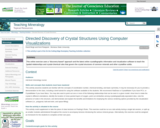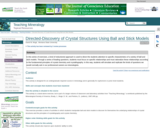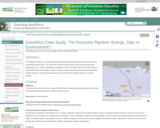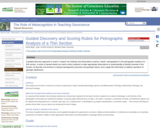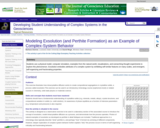Show Caption
Hide This diagram shows the relationship of Gibbs Free Energy to composition. In this diagram there are two minima represented for free energy which is achieved by unmixing of two distinct phases each with definite composition. The dashed line, which is tangential to the two minima in the free energy curves, gives the composition of the coexisting minerals at a specific temperature. From: Klein, C., and Dutrow, B., Manual of Mineral Science, 23rd ed., J. Wiley and Sons. Used with permission. The phenomenon of solid solution is common in many rock-forming minerals. At high temperatures, thermal vibrations permit accomodation of ions with size differences on the order of 15-30%. However, as physical conditions change, ions no longer fit into similar sites which creates internal (lattice) strain energy. Consequently, the mineral composition must adjust to relieve this strain energy and minimize the Gibbs Free Energy of the system. One possible response of the system is for elements in a crystal to move from one chemical site to another via intracrystalline diffusion. This results in segregated domains that are enriched in one element or another--this is a process called exsolution.
A good example of this process can be seen in the alkali feldspar mineral group. At high temperature the mineral anorthoclase (K,Na)AlSi3O8 shows complete solid solution, i.e. there is a random distribution of K and Na in the alkali sites of the crystal. Upon cooling, Na and K segregate into more ordered domains creating areas that are rich in albite NaAl Si3O8 and microcline KAlSi3O8(see Figure 1).
The purpose of this exercise is to provide a number of activities to demonstrate how exsolution works and to demonstrate complex-system behavior in this relatively common natural phenomenon.
Part I: Images of naturally occurring perthite.
The following images show minerals that have undergone exsolution at different scales. The image on the top left shows exsolution as viewed with a Transmission Electron Microscope (TEM; field of view is 10 microns). The image on the top right is a photomicrograph of exsolution in microcline as seen in thin section (cross-polarized light, field of view is 2 mm). The picture on the bottom left is a hand sample of perthitic microcline as seen in hand sample (field of view is 10 cm). The picture on the bottom right is a picture of plagioclase feldspar showing the "schiller" effect. This is caused by sub-microscopic unmixing of two distinct plagioclase phases in the compositional range of labradorite (An50 - An70) which results in the beautiful play of colors seen in this photo; (field of view of 20 centimeters). This series of pictures is a good example of scale invariance of this physical phenomenon.
Examine perthite textures from hand samples and thin sections from your own mineralogy collection. We can easily envision unmixing of two immiscible fluids--for example oil and vinegar salad dressing. The same thing happens when we unmix (i.e. exsolve) solid phases--the process just takes a bit longer as atoms have to migrate in the crystal lattice by intracrystalline diffusion! How can such a common feature as perthite be understood in terms of complex-system behavior?
Exsolution observed on a sub-microscopic scale in this TEM picture; this microstructure shows unmixing of labradorite in very fine essentially parallel lamellae. From Champness, P.E., and G.W Lorimer, 1976. Exsolution in silicates. Chapter 4.1 in Electron Microscopy in Mineralogy. H.R. Wenk, ed. Springer-Verlag, New York. Field of view is 10 microns.
Perthite observed in thin section. Field of view is 2 mm.
Perthite observed in hand sample. Field of View is 10 cm.
Unmixing of parallel lamellae, as observed in a hand specimen of labradorite from Madagascar. These lamellae act as diffraction grating for white light, producing spectral colors known as labradorescence or the "schiller effect"; the field of view is 20 cm. Photo by B. Dutrow; used by permission.]
Part II: Exsolution Puzzle Exercise.
This exercise is done in groups of 2-3 students. Coins are initially randomly distributed on a chessboard, and are then subsequently moved to create domains of increasing order (regions that are dominated by either pennies or nickels). This is a kinesthetic learning exercise that creates a physical model that simulates how the exsolution process works. (Inspired by Greg Marfleet, Carleton College)
Randomly distribute 20 pennies and 20 nickels on the attached 7x7 chessboard (Microsoft Word 33kB Dec1 10). The random distribution of pennies and nickels is analogous to the random distribution of Na and K in the high temperature alkali feldspar, anorthosite. (See Figure 1)
The goal is to have a given coin completely surrounded by similar neighbors (i.e. 8 nearest neighbors of the same type of coin located on adjacent edges and the diagonal squares. Each student will sequentially move a coin into an adjacent open position (horizontal, vertical and diagonal moves are allowed) to achieve this desired configuration. Perfect ordering of nickels and pennies into discrete domains is analogous to perfectly ordered crystals of albite and microcline. [NOTE: in this exercise we are modeling the diffusivity of only the alkali elements, Na and K. The ordering of Si and Al in the tetrahedral sites of a feldspar crystal is a related, but entirely different process].
Systems tend to minimize Gibbs Free Energy (see Figure 2) on their way towards a state of equilibrium. In this example, the surface area surrounding domains of the segregated compositions (nickels/Na and pennies/potassium) is proportional to the excess Gibbs Free Energy of those domains. As clusters of similar coins evolve (segregate) and get bigger, the bounding surface areas are minimized and the energetics of the system are decreased.
INSTRUCTIONS
For the initial random state, determine the area surrounding each type of element; do this by assuming the unit length along each edge is 1 and add all the surfaces surrounding Na/nickel and K/potassium coins or aggregates of coins. Count any edges that are not adjacent to another similar coin (i.e. count all nickel-penny interfaces, and any edge where a nickel or penny is adjacent to an open space. Do not count the external edges on the outer border of the chessboard).
Make 10 moves of the coins (always moving into an adjacent open space either right, left, up, down, or on a diagonal) and again determine the bounding surface areas. Record these surface area values for pennies and nickels. Repeat after 20, 30, 40, 50, and 100 moves.
After each set of moves, report your surface area measurements for both pennies and nickels to your instructor; record these values on a spread sheet for later plotting and analysis.
This part of the exercise should take about 45 minutes to complete the sets of movements and measurement of the surface areas.
Here is an example experiment showing the progressive ordering of pennies (potassium) and nickels (sodium). Show pictures of the 2-D distribution of pennies and nickels after 10,20, 30, 40, 50 and 100 successive moves
Hide
Original random distribution of coins.
Distribution of coins after 10 moves.
Distribution of coins after 20 moves.
Distribution of coins after 30 moves.
Distribution of coins after 40 moves.
Distribution of coins after 50 moves.
Distribution of coins after 100 moves; perfect order.
Plot your results. Assume that each move requires 1 unit of time.
Plot your data on a X-Y plot with surface area on the Y axis and time on the X-axis. What is the distribution of your data? (Try plotting data for pennies, nickels, their sum, and their averages). Create a "best fit" curve through the data as plotted on this X-Y diagram (easily done with functions programmed into Excel). . What type of mathematical function is represented by a curve that has a steep slope to begin (left side of the plot), and becomes asymptotic to the X-axis away from the origin? Did you notice that the first set of coin moves produced the largest change in surface area, and that subsequent sets of moves produced smaller and smaller changes to the surface area?
Have you seen other plots with similar profiles from your other studies in Earth Science?
Show Answer:
Hide radioactive decay; longitudinal profile of rivers.... It appears that many processes in Earth Science may follow the same mathematical laws.
Now plot your data on a log-log plot with surface area on the ordinate (Y-axis) and time on the abscissa (X-axis). Create a "best fit" curve through these data (easily done with functions programmed into Excel). What is the shape of this curve? Does this relationship demonstrate a) an exponential function? b) a power law?
Here is an example dataset (Excel 74kB Dec1 10) for 12 experiments completed by the spring 2010 Mineralogy class at Montana State University. Raw data and corresponding graphs are presented in the attached spreadsheet file. Compare your results with those shown in this example exercise.
Intracrystalline Diffusion and Fick's Law
The rate of transport of mass (and energy) through a fixed medium can be described mathematically by Fick's Law of Diffusion. Show details about Fick's Law of Diffusion
Hide.
The fundamental expression of Fick's First Law of Diffusion can be written as:
J = -D( -- c/ -- x)
Jis the flux of a material along a compositional gradient (e.g. mol / length2time1 ), the amount of material (e.g. atoms or moles) that will flow through a small area during a fixed time interval.
Dis the diffusion coefficient (length2 time -1);
c is the concentration (amount of material per volume, mol/m3), and
x is the length (m)
Fick's Law shows that the flux of an ion diffusing through a stationary medium (like the crystalline lattice in our example) is proportional to the concentration gradient ( -- c/ -- x). As diffusion proceeds, the concentration is always changing, and thus, the flux is always changing. Can you see why this process exhibits non-linear behavior and must be represented as a power law?
Note that The diffusivity, D, scales with temperature:
D ~ (kT/h) exp(-Q*/RT)
where k is Boltzmann's constant, h is Planck's constant, and Q* is an activation energy. This means that the rate of diffusion decreases with temperature. Consequently, exsolution will ultimately grind to a halt as temperature decreases. This is why we can observe perthite development in alkali feldspars in a wide variety of igneous and metamorphic rocks...the perthite texture gives us information about the cooling history of the mineral up to a point, but then exsolution will slow to a stop and the perthite will continue to exist in a metastable state at the surface of the earth.
Different types of diffusion pathways include: intragranular (volume) diffusion, grain boundary diffusion, diffusion in a bulk fluid, and diffusion related to crystal defects. In our example of perthite exsolution, intragranular (volume) diffusion is the operative process. This process is most effective at high temperatures.
Note that generally material tends to move in a direction from high to low concentrations, and thus, compositional gradients tend to be minimized by diffusion. However, in the case of exsolution and perthite development during cooling of a high-temperature, homogeneous alkali feldspar (anorthite), just the opposite effect happens--segregated domains of albite and microcline become more stable at lower temperatures. Why is this the case? The answer lies in the overall energetics of the system. It turns out that lattice strain that is induced upon cooling of anorthite results in large excess energy in the system. To minimize this excess energy, a single homogeneous grain of anorthite (stable at high temperature), will undergo "spinodal" decomposition upon cooling. This results in two energy minima, one for each phase, as illustrated in Figure 2. Upon further cooling, these energy minima continue to separate, thus resulting in two stable phases whose compositions increasingly approach the end member compositions of albite and microcline. A more complete description of this process can be found in Chapters 5 and 7 of Putnis A. and McConnell J.D.C. Principles of Mineral Behaviour 258pp. Blackwell Scientific Publications. Oxford. 1980.
Part III: Computer Simulation
Model output from the NetLogo "segregation"program; 2000 objects achieved 70% similarity.The computer program NetLogo can be used to model complex system behavior. This computer program was developed by Uri Wilensky (1999) at the Center for Connected Learning and Computer-Based Modeling, Northwestern University. Evanston, IL. For this exercise, we will use the pre-programmed function for Segregation
Experiment with this program by changing the input parameters to try to reproduce a) the pattern you developed in the puzzle model above, and b) perthite patterns observed in the natural microcline crystals.
Part IV: Visualization of the Development of Exsolution
The binary solvus phase diagram for the alkali feldspar system at low pressure. Figure provided by Dexter Perkins, used with permission.The binary "solvus" phase diagram (showing the relation of temperature to composition) is typically used to show the phase relations for alkali feldspars. A single homogeneous alkali feldspar occurs at high temperatures (Figure 1a), but as the system cools eventually the phase boundary (solvus) is intersected and the exsolution (unmixing) process begins. "Underneath" the solvus a single feldspar is no longer thermodynamically stable, and the system begins to separate into two phases that become increasingly Na-rich or K-rich upon further cooling. This visualization demonstrates the cooling history of an alkali feldspar, including use of the "lever rule" to calculate phase composition (mineral) and relative proportions. Examine the accompanying illustrations and track the "state" of the system as temperature changes. Binary Solvus for the Alkali Feldspar System. The accompanying illustrations on the right show the "state of the system" in terms of the relative proportions of the phases present for each assigned temperature.
Relate these products and processes to natural occurrences of perthite, and think about the changes that have to take place on the atomic scale to produce the mesoscopic features that are visible in hand samples.
Part V: Thought Questions
Driving forces: in equilibrium thermodynamics, the system always drives towards the lowest Gibbs Free Energy. At equilibrium, chemical potential is zero. This typically means there are no compositional gradients. Why does this system drive towards segregated domains that are rich in Na and K?
Consider entropy "in the system". What do we mean by "the system"?
Refer to Ilya Prigogine's (winner of the 1977 Nobel Prize for Chemistry) classic work on this subject: Order out of Chaos, Man's New Dialogue with Nature (1984, Bantam Books, 394 pp.)
(Note: this resource was added to OER Commons as part of a batch upload of over 2,200 records. If you notice an issue with the quality of the metadata, please let us know by using the 'report' button and we will flag it for consideration.)




